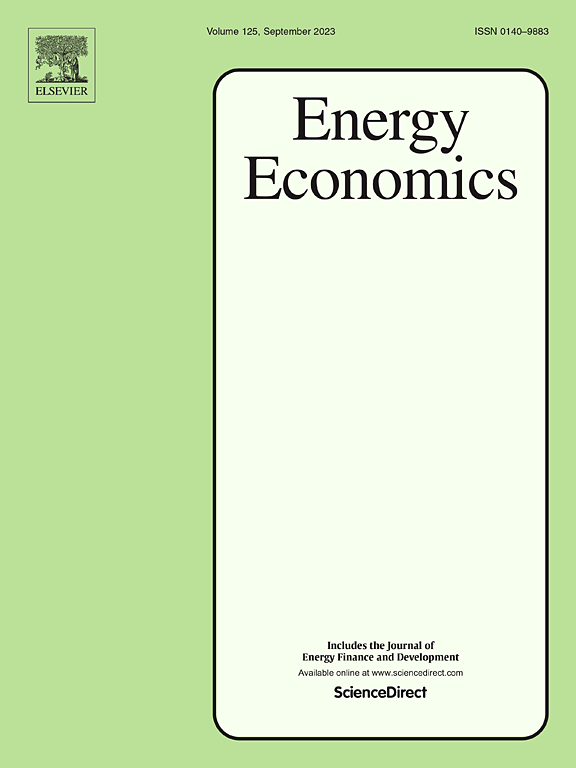Green power-TGC-CET conversion mechanism design, dynamic evaluation and selection: Enhancing multi-market synergy
IF 13.6
2区 经济学
Q1 ECONOMICS
引用次数: 0
Abstract
The design of conversion mechanisms for environmental equity products is crucial to strengthen the synergistic development of the carbon emission trading (CET), tradable green certificate (TGC) and green power trading markets. First, this paper measures the carbon reduction of renewable energy generators (REGs) by using the life cycle assessment (LCA) method, and designs the conversion mechanisms between green power, TGC, China certified emission reduction (CCER) and carbon allowance (CA) from the perspective of carbon offset, carbon reduction and techno-economic cost. Then, the multi-time coupled model with the synergy of green power-TGC-CET is constructed to evaluate the effect of various conversion mechanisms on the multiple markets and participants' behavioral decisions. Finally, the best conversion mechanism is selected from the perspectives of effectiveness and efficiency. The results show that green power-TGC-CCER-CA conversion mechanisms promote the development of renewable energy (RE) and carbon reduction, and effectively help China's national CET market to include more key emitting sectors. The green power-TGC-CCER-CA conversion mechanism, based on carbon reduction, is optimal for improving the economic and environmental effects, and enhancing the vitality and competitiveness of markets. These insights can enrich research on the conversion mechanism between environmental equity products and provide mechanisms selection for the future dynamic adjustment of favorable linkage and synergy between green power-TGC- CET markets.

绿色电力- tgc - cet转换机制设计、动态评价与选择:增强多市场协同效应
环境权益产品转换机制的设计对于加强碳排放权交易(CET)、可交易绿色证书(TGC)和绿色电力交易市场的协同发展至关重要。首先,采用生命周期评估(LCA)方法对可再生能源发电机组(REGs)的碳减排量进行测度,并从碳抵消、碳减排和技术经济成本的角度设计绿色电力、TGC、中国认证减排(CCER)和碳配额(CA)之间的转换机制。在此基础上,构建了绿色电力协同作用下的多时间耦合模型,评估了不同转换机制对多市场和参与者行为决策的影响。最后,从有效性和效率的角度选择最佳转换机制。研究结果表明,绿色电力- tgc - ccer - ca转换机制促进了可再生能源的发展和碳减排,有效地帮助中国国家能源市场纳入更多的关键排放行业。以碳减排为基础的绿色电力- tgc - ccer - ca转换机制是改善经济和环境效应、增强市场活力和竞争力的最佳选择。这些见解可以丰富对环境权益产品之间转换机制的研究,为未来绿色电力-电力-电力市场良性联动协同的动态调整提供机制选择。
本文章由计算机程序翻译,如有差异,请以英文原文为准。
求助全文
约1分钟内获得全文
求助全文
来源期刊

Energy Economics
ECONOMICS-
CiteScore
18.60
自引率
12.50%
发文量
524
期刊介绍:
Energy Economics is a field journal that focuses on energy economics and energy finance. It covers various themes including the exploitation, conversion, and use of energy, markets for energy commodities and derivatives, regulation and taxation, forecasting, environment and climate, international trade, development, and monetary policy. The journal welcomes contributions that utilize diverse methods such as experiments, surveys, econometrics, decomposition, simulation models, equilibrium models, optimization models, and analytical models. It publishes a combination of papers employing different methods to explore a wide range of topics. The journal's replication policy encourages the submission of replication studies, wherein researchers reproduce and extend the key results of original studies while explaining any differences. Energy Economics is indexed and abstracted in several databases including Environmental Abstracts, Fuel and Energy Abstracts, Social Sciences Citation Index, GEOBASE, Social & Behavioral Sciences, Journal of Economic Literature, INSPEC, and more.
 求助内容:
求助内容: 应助结果提醒方式:
应助结果提醒方式:


